Tag archives: optics
Leaping across the innovation divide
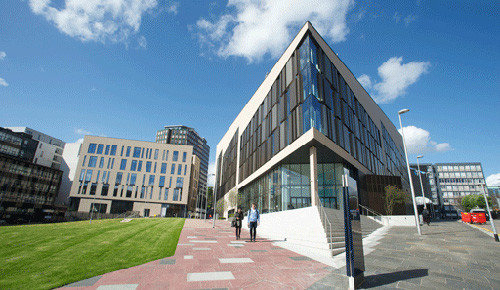
Glasgow’s Technology and Innovation Centre. (Courtesy: University of Strathclyde)
By Margaret Harris in Glasgow
If you’re the first speaker after lunch at a conference, how do you make sure your audience stays awake and engaged?
For Oliver Ambacher – who occupied the dreaded post-prandial slot during Wednesday’s applied photonics conference at Glasgow’s Technology and Innovation Centre (TIC) – the answer is simple. You pretend to jump off a cliff.
Ambacher, the director of the Fraunhofer Institute for Applied Solid State Physics in Freiburg, Germany, made his leap (actually, several leaps of varying lengths) to illustrate one of the toughest challenges in applied physics: the yawning gap between what academic researchers can provide, and what industry scientists need to turn that research into innovative products. This gap is sometimes called the “valley of death”, and Ambacher’s point was that the risks of leaping across it are generally higher on the industry side. “If I, whose heart is still in physics, jump into the valley of death, I lose funding, maybe a project,” Ambacher explained. “But somebody from industry, they may lose their job. So they cannot jump so far.”
View all posts by this author | View this author's profile
Horsing around with some innovative physics

(Left to right) Physicists Giedre Podolyak, Steve Roberts and Snezhana Chater of Hallmarq Veterinary Imaging celebrate their success in the IOP Innovation Awards.
By Margaret Harris
Imagine you’re a veterinarian and a trainer asks you to take a look at a horse. The animal, a champion showjumper, is limping slightly but there is no obvious injury. Exploratory surgery would probably do more harm than good, and the alternative – magnetic resonance imaging (MRI) – isn’t risk-free either. You’d need to put the horse under a general anaesthetic, and you know horses don’t react well to that; in fact, around 0.5% suffer serious injuries while coming round afterwards. And that’s assuming you can even find a scanner big enough to fit a horse. What do you do?
This might sound like a fairly niche dilemma, but for Hallmarq Veterinary Imaging it has become the basis for a thriving business – a business, moreover, that has just won an IOP Innovation Award for the successful application of physics in a commercial product.
At the awards ceremony – which took place last night in the Palace of Westminster, London, just down the hall from the House of Commons chamber – I caught up with Hallmarq’s operations and technical director, Steve Roberts. After sketching out the scenario of the veterinarian and the injured horse, Roberts, a physicist, explained that Hallmarq’s MRI scanner fits around the horse’s leg. This means that equine patients can simply be led into it, sedated but conscious. Sophisticated error-correction and image-processing software helps the scanner compensate for the horse’s movement, and in 15 years of operation, Roberts estimates that veterinarians have used Hallmarq’s machines to scan more than 60,000 horses.
International Year of Light 2015: our top 10 articles on light now with added videos
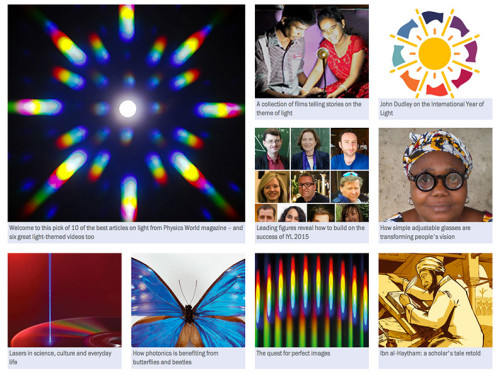
Celebrate IYL 2015 with a special free-to-read digital edition of Physics World – now updated to include light-themed films and a look ahead to the legacy the year will leave.
By Matin Durrani
We’re now in the final quarter of the International Year of Light (IYL 2015), which officially launched in January at the headquarters of the UN Educational, Scientific and Cultural Organization (UNESCO) in Paris. You may remember that on the very same day Physics World unveiled its own contribution to the IYL in the form of a free-to-read digital edition containing 10 of our very best feature articles on the science and applications of light.
Today we’re pleased to publish a new version of that digital edition, which contains the same 10 top articles but now includes a series of great videos and a podcast on the theme of light that we’ve been busy creating over the last few months. The refreshed digital edition also has interviews with some of the people involved in the IYL, in which they highlight some of the successes of the year so far and examine the legacy the IYL will leave behind. Click here to find out more.
The July 2015 issue of Physics World is now out
By Matin Durrani
Sometimes, nature does something unexpected – something so rare, transient or remote that only a lucky few of us get to see it in our lifetimes. In the July issue of Physics World, we reveal the physics behind our pick of the weirdest natural phenomena on our planet, from dramatic rogue waves up to 30 m tall, to volcanic lightning that can be heard “whistling” from the other side of the world, and even giant stones that move while no-one is watching. We also tackle tidal bores on rivers and the odd “green flash” that is sometimes seen at sunset.
Plus, we’ve got six fabulous full-page images of a range of weird phenomena, including salt-flat mirrors, firenadoes, “ice towers”, beautifully coloured nacreous clouds, mysterious ice bubbles of gas trapped in columns, as well as my favourite – the delicately wonderful “frost flowers” seen very occasionally on plants.
Physics World 2015 Focus on Optics & Photonics is out now
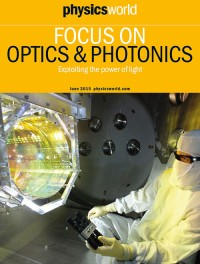 By Matin Durrani
By Matin Durrani
With the 2015 International Year of Light now in full swing, it’s time to tuck into the latest focus issue of Physics World, which explores some of the latest research into optics and photonics.
The focus issue, which can be read here free of charge, kicks off by looking at the giant laser interferometers underpinning the latest searches for gravitational waves. We also report on recent efforts to use optical instead of radio waves for satellite communication and have an interview with Ian Walmsley from the University of Oxford about the vital role that optics and photonics play in the UK’s new £270m Quantum Technologies Programme.
View all posts by this author | View this author's profile
IYL 2015 gets Swiss design makeover
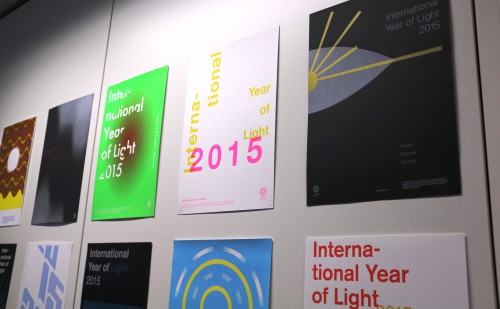
IYL 2015 is the theme of this student poster project.
By James Dacey
One of the big aims of the International Year of Light (IYL 2015) is to take scientific ideas out of the lab to show the world just how inspiring and useful they can be. In the process, it can forge relationships between different communities, including scientists, engineers, artists, journalists, architects, politicians, aid workers…the list goes on.
Here in Bristol, where Physics World is produced, we’ve seen a fantastic local example of this by way of an art project at the University of the West of England (UWE). Second-year graphic-design students were set the brief of creating posters themed on IYL 2015. Last night we hosted an evening at IOP Publishing headquarters to showcase the students’ work and to let them find out more about science publishing.
View all posts by this author | View this author's profile
A journal for brief ideas, Heisenberg’s mirror, space-mission stickers and more
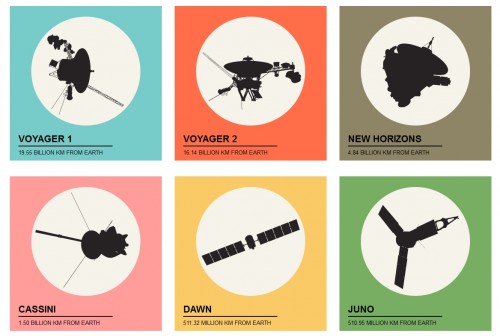
Mission accomplished: these graphics were created by Ariel Waldman and Lisa Ballard. (Courtesy: spaceprob.es)
By Hamish Johnston
“Dr Heisenberg’s Magic Mirror of Uncertainty” is the name of a series of photographs taken in 1999 by the American photographer Duane Michals. The picture over at that link is lovely, but I don’t really see the connection to quantum mechanics. I suspect my artist friends would accuse me of being a scientific literalist, which doesn’t bother me one bit.
More to my liking are the graphics pictured above, which have been created by Ariel Waldman and Lisa Ballard. The pair run a website called spaceprob.es, which “catalogues the active human-made machines that freckle our solar system and dot our galaxy”. Here is their page on Voyager 2, which is packed with facts about the mission’s instruments and many accomplishments. These and other illustrations of space missions can be bought as stickers and posters – the perfect gift for the space enthusiast in your life.
Flying high in Baltimore
By Susan Curtis in Baltimore, US
After two days of getting to grips with biophysics – see here and here for my experiences – I was ready for a change of scene. And a visit to the Space Telescope Science Institute (STScI), co-located with the Johns Hopkins University in Baltimore but operated on behalf of NASA, was just what I needed.
The STScI is home to many of the scientists and engineers who made the Hubble Space Telescope possible, and who have been working for many years to design the optics and instrumentation for its successor – the James Webb Space Telescope (JWST), which is due to be launched in 2018. The institute also runs the science operations for Hubble and soon will for the JWST, providing software tools for astronomers to make their observations and processing the raw data acquired by the onboard instruments to make it ready for scientific analysis.
Photonics by the Bay
By Margaret Harris in San Francisco
The International Year of Light is a global celebration, but right now, it’s definitely got its heart in San Francisco. For the past five days, experts in optics, lasers and biomedical imaging have been converging on the “city by the bay” for the annual Photonics West conference, and I’ve joined them in order to learn more about the hot topics in optical science.
View all posts by this author | View this author's profile
Physics meets biology in Baltimore
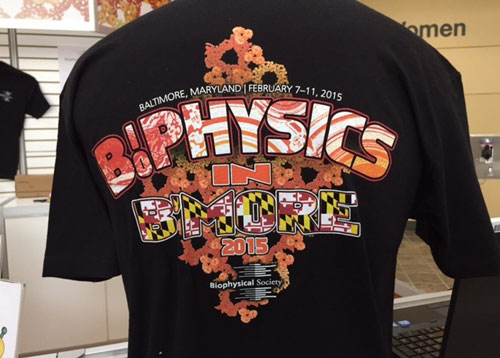
Biophysics in Baltimore: the T-shirt that does what it says on the tin.
By Susan Curtis in Baltimore, US
I’m in Baltimore this week for the 59th annual meeting of the Biophysical Society. The field of biophysics has grown rapidly in recent years as physics-based techniques have opened up new ways to study and understand biological processes, but with my limited knowledge of biology I was nervous that I would feel a little out of my depth.
The first talk of the “New and Notable” symposium helped to allay my fears. Michelle Wang is a physicist at Cornell University in the US who exploits optical techniques to trap and manipulate biomolecules. While established methods can only trap a single biomolecule at a time, Wang and her colleagues have pioneered the use of nanophotonic structures that can trap multiple biomolecules in a standing wave created within an optical waveguide.
“Our optical-trapping innovation reduces bench-top optics to a small device on a chip,” Wang told physicsworld.com when the team first reported their so-called nanophotonic standing-wave array trap last year. Since then, Wang and her colleagues have been working to integrate fluorescent markers with the nanophotonic trap to track the position of individual biomolecules, and have also been experimenting with optical waveguide materials other than silicon to improve performance and enable new applications.
View all posts by this author | View this author's profile